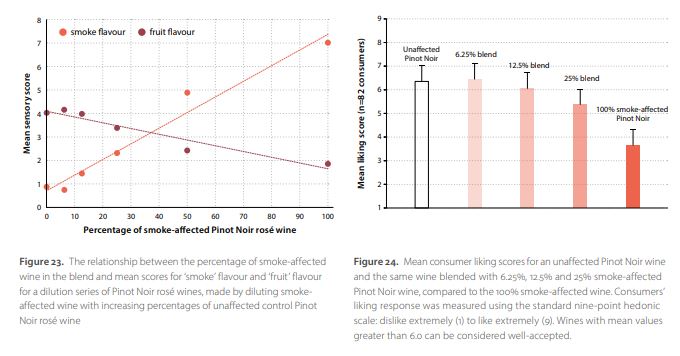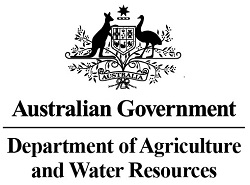Mitigation of climate change impacts on the national wine industry by reduction in losses from controlled burns and wildfires and improvement in public land management
Project summary
This is a collaborative project with partners including Wine Australia, the Australian Government Department of Agriculture and Water Resources, Agriculture Victoria, La Trobe University, Wine Victoria and the AWRI. The AWRI’s role is to evaluate a range of possible remedial management options and processing tools for dealing with smoke-affected grapes and wine. This is especially important as smoke taint is known to develop during bottle ageing of wine through continued conversion of non-volatile glycosides from contaminated grapes into their free volatile forms. In addition, the AWRI is collaborating with Agriculture Victoria/La Trobe to evaluate vineyard-based monitoring, preventative and remedial management options for dealing with the variable composition of atmospheric smoke and associated risk of smoke taint in wine.
This project is supported by Wine Australia, through funding from the Australian Government Department of Agriculture and Water Resources as part of its Rural R&D for Profit program and the Australian Wine Research Institute.
Latest information
Winemaking trials with activated carbon
Fining with activated carbon is one option for remediating smoke-affected juice and wine. Winemaking trials were performed with 2019 smoke-affected Chardonnay and Pinot Noir (rosé style) juices using two activated carbon products (PS1300 and CASPF) at three dose rates (1, 2 and 4 g/L). Juices were treated with the carbon products prior to fermentation, with bentonite added to assist in settling after a contact time of 48 hours. Six weeks post-bottling, the finished wines underwent sensory evaluation by a trained sensory panel using descriptive analysis. Activated carbon treatment at the highest dose rate (4 g/L) was shown to remove up to 87% and 98% of glycosides quantified for Pinot Noir rosé and Chardonnay, respectively (Figure 21). However, when fined at the higher carbon dose rates, the wines became stripped of flavour and aroma (both positive and negative) and very un-wine-like, described by the sensory panel as having a ‘cooked vegetable’/‘drain’ character. At the lowest carbon dose rate (1 g/L), the smoke-related attributes in the Pinot Noir rosé wines were decreased while still maintaining some positive ‘fruity’ and ‘confection’ aromas (Figure 22). Consequently, a fine balance is needed to add activated carbon at a rate that will decrease smoke characters while still retaining some positive flavour and aroma attributes. Carbon-treated wines may also require additional blending with a non-affected wine to blend away any residual smoke characters while increasing varietal aromas and flavours.


The appropriate carbon addition for a particular situation will be dependent on the level of taint compounds in the juice. However, it is important to note that the OIV recommends using carbon additions of less than 1 g/L for both juices and wine, with fining rates of 50 to 500 mg/L typically used for the removal of odours. In addition, for some carbon types, the addition of larger quantities could result in the release of metals into the juice or wine. While all activated carbon products evaluated in this work were commercially available, it is recommended that wineries contact product manufacturers to ensure that their product adheres to the relevant food standards code for use in wine production.
Dilution studies
Dilution with an unaffected wine is another option for managing a smoke-affected wine, with the goal of diminishing or eliminating smoke-related sensory characters. This option was evaluated using a smoke-affected 2019 Pinot Noir rosé wine. The smoke-affected wine was blended with an unaffected Pinot Noir wine of a similar style sourced from the same vintage, to produce a dilution series of six samples: 100% smoke-affected wine, 50%, 25%, 12.5%, 6.25% and 0% (equivalent to 100% unaffected wine). Wines were assessed by members of the AWRI’s technical quality panel for ‘smoke’ aroma and flavour and ‘overall fruit’ aroma and flavour (flavour data shown in Figure 23). As expected, the 100% smoke-affected wine was scored significantly higher (P < 0.05) in ‘smoke’ aroma and flavour than the unaffected wine and was the lowest scoring wine for ‘overall fruit’ aroma and flavour. Dilutions of the affected wine with 75% or more unaffected wine resulted in ‘smoke’ aroma and flavour scores not significantly different from the unaffected wine. Overall, this study with rosé wine confirmed that blending can be an effective option for the remediation of smoke-tainted wine and can decrease ‘smoke’ aroma scores in a linear manner associated with the volume of tainted wine in the blend (Figure 23).

Consumer acceptance of smoke characters in wine
As part of the work on dilution, a study was conducted to assess the impact of smoke characters on consumer acceptance. Five of the Pinot Noir rosé dilution series wines were assessed by consumers: the unaffected wine, the blends with 6.25%, 12.5%, and 25% of the smoke-affected wine and the 100% smoke-affected wine. Eighty-two regular consumers of rosé wine rated each wine for overall liking on a nine-point hedonic scale from ‘dislike extremely’ to ‘like extremely’. The wines were assessed under blind tasting conditions and were presented in black glasses to avoid any visual cues. The consumers were not given any information about the purpose of the tasting.
A highly significant difference (P<0.001) was found among the wines, with the mean liking data shown in Figure 24. The liking score for the smoke-affected wine was very low, with a mean value of 3.7. In consumer testing using the hedonic scale, a value of 6.0 or above generally indicates a well-accepted product and a value less than 5.0 indicates a poorly accepted product. The unaffected commercially available Pinot Noir rosé wine was well-liked, as expected, with a score of 6.4. The liking scores for the unaffected wine and the same wine blended with 6.25% of the smoke-affected wine were similar, indicating that the addition of this proportion of the smoke-affected wine did not have a negative effect on consumer liking. The 12.5% and 25% blends were lower in liking score, with the 25% blend being well below the score of the unaffected wine. Overall, there was a strong negative correlation between the proportion of the smoke-affected wine in the blends tasted by the consumers and their liking score. Results from this study show that a smoke-affected wine is not accepted by consumers and provides evidence that even a small proportion of smoke-affected wine in a blend can seriously affect consumer acceptance. Only a minority of consumers did not respond negatively to smoke. Additional consumer studies would be required to determine if this finding holds true for other smoke-affected wines with differing degrees of smoke influence and of different varieties and styles.
Glycosidase enzyme and carbon treatment of wine
Glycosidase enzyme treatment followed by fining with activated carbons (PS1300 or FPS) was assessed in winery trials with a smoke-affected full-bodied Pinot Noir dry red wine, to determine if this would reduce the concentration of phenolic glycosides and volatile phenols in the wine. Treating the smoke-affected Pinot Noir wine with the Trenolin Bouquet enzyme product at its maximum recommended dose at 25°C for eight days reduced the concentrations of six phenolic glycosides by approximately 50%. Results mirrored those observed in laboratory studies, with the glucose-glucose glycosides (gentiobiosides) being predominantly cleaved by the glycosidase enzyme. The enzyme treatment increased the total volatile phenols compared to the control wine from 132 to 146 µg/L. Subsequently, the concentration of volatile phenols could be decreased by carbon fining in a dose-dependent manner. Mean smoke taint sensory scores for the control and treatments demonstrated that the carbon treatments (with or without prior glycosidase enzyme addition) were more effective in reducing smoke taint ratings than the enzyme treatment alone (Table 5). Wines that had been treated with the enzyme were still reported as having obvious ‘smoke’-related aromas and flavours. While for many of the treatments a decrease of ‘smoke’ intensity was observed, wines were also described as appearing very stripped and lacking positive ‘fruit’ aromas and flavours, which is consistent with previous knowledge about sensory effects of carbon fining. Further work with wines of different varieties and different levels of taint is warranted to fully explore this option for treating smoke-affected wines.
Collaborative work
The AWRI is collaborating with the University of Adelaide’s Industrial Transformation Training Centre on smoke taint research. During the year, assistance was provided for one PhD project investigating the uptake of smoke molecules in grapes.
A new two-year project with the University of Adelaide, PIRSA, Grain Producers SA, the SA Grain Industry Trust and La Trobe University commenced in 2019 to assess the potential impact of smoke from stubble burns on grapes and wine, with funding obtained from the South Australian Wine Industry Development Scheme.
In response to the Cudlee Creek, SA fires in December 2019, a new research project was initiated with funding provided by PIRSA to assess the impact of early-season smoke exposure on taint markers in grapes and wine, as well as wine sensory characters. Following the fire, grapes and leaves were collected from a total of 24 Chardonnay, Pinot Noir and Shiraz vineyards in the Adelaide Hills with different degrees of smoke exposure and fire damage. Additional analysis of Shiraz and Chardonnay berry and leaf samples from the Hunter Valley is complementing the Adelaide Hills research and will provide a better understanding of the effects on grape composition of cumulative smoke exposure over an extended period of time.
Project Contact
Markus Herderich, Mark Krstic
Find out more


